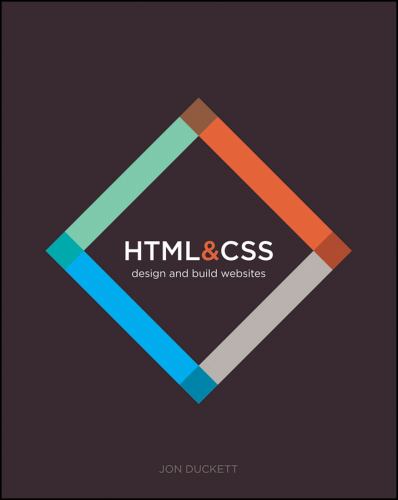HTML & CSS: Design and Build Websites by Jon Duckett

I recently purchased a stack of development books on a range of topics, so this will be the first in a series of reviews. Jon Duckett has a 3-volume series on web development from the basics of HTML and CSS to Javascript & jQuery to PHP and MySQL. They were all well-reviewed so I picked up the lot with the intention of brushing-up. HTML & CSS: Design and Build Websites (HTML & CSS) is a foundational introduction to its titular languages. It’s a thick paperback, almost 500 pages, and it’s stuffed with graphics, code samples, and exercises to follow along with. The first two sections of the book describe the form and function of HTML and CSS respectively. Then a third, smaller section provides some practical information about structuring websites. Topics include visual hierarchy, designing navigation, SEO, audience considerations, and more.
Pros:
The most striking thing about HTML & CSS is how unlike a conventional textbook it is. The high number of graphics make it very readable, so I burned through it in only a few sessions despite its length. All of the essentials for HTML5 in particular are covered, and the CSS information is accurate up to the point of publication. It came out around 2011, right when HTML5 and CSS3 were coming into fashion, so the bulk of the information is still relevant today. Duckett does a good job of showing not only the how of development, but the why as well. The practical section may be the highlight, as it illustrates some of the best practices for planning and conceptualizing a website beyond merely coding it. That extra guidance elevates HTML & CSS beyond a simple code reference to a more comprehensive guide for professional-grade development.
- Appealing visual design
- Quick read
- Lots of diagrams and code samples
- Relevant to HTML5 and CSS3
- Includes practical information too
Cons:
Because it was published in 2011, there are some sections that have become obsolete. The CSS3 information is still accurate, but further additions to CSS3 since the book’s publication have rendered it incomplete. For example, the section on floats is probably more prominent than it needs to be. Those have been largely eclipsed by flexbox and grid, which get no mention because they did not exist yet at the time of publication. That’s a problem, because flexbox and grid are now the foundation of CSS positioning. There is also an entire section on Flash, which gradually died in the advent of HTML5 video. At this point it is effectively dead. Internet Explorer has thankfully gone extinct as well, so any mention of style hacks for that browser are no longer needed. It’s nice that they were included for the time, however, as grappling with Internet Explorer was about half the job at one point in time.
- Starting to show its age in some places
- No flexbox or grid
- Flash and IE sections are obsolete
Final Thoughts:
On the whole, a beginner to web development with no experience who is looking to jump right into building simple websites could easily do so with this book alone. I would definitely recommend it to someone in that situation with the caveat that they should ignore the few obsolete sections and look into flexbox and grid. The rest of the information is still relevant, and the visual nature of the book’s design make it a good reference even for experienced developers. A revised edition with up-to-date info would be absolutely killer. I’m glad I picked it up and look forward to reading Duckett’s other books.